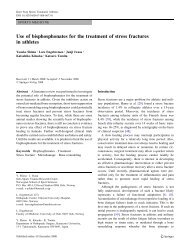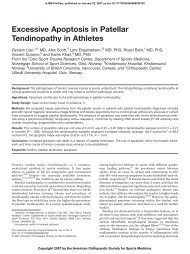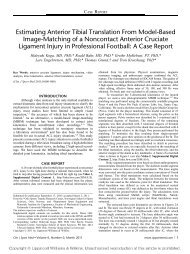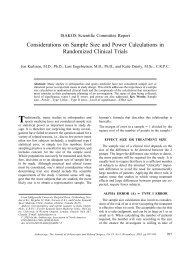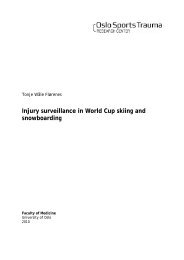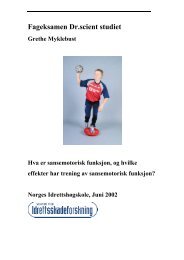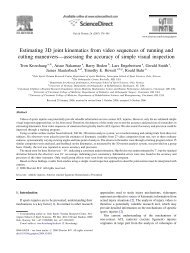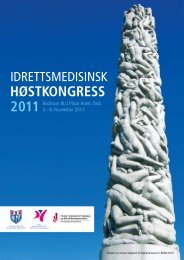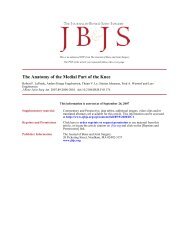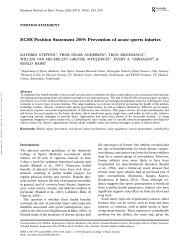Self-reported psychological characteristics as risk factors for injuries ...
Self-reported psychological characteristics as risk factors for injuries ...
Self-reported psychological characteristics as risk factors for injuries ...
You also want an ePaper? Increase the reach of your titles
YUMPU automatically turns print PDFs into web optimized ePapers that Google loves.
Psychological <strong>risk</strong> <strong>factors</strong> <strong>for</strong> <strong>injuries</strong>hamsen et al., 2006), a multidimensional sport per<strong>for</strong>mancetrait anxiety inventory, provided three sub-dimensions: somaticanxiety (nine items), worry (seven items) and concentrationdisruption (five items), respectively.Entry w<strong>as</strong> required <strong>for</strong> one out of the two responsealternatives (modified LESCA) and on a four-point Likertscale (strongly agree to strongly disagree) (SAS-n). Forboth questionnaires, the players were <strong>as</strong>ked to indicate thoseitems of life events (modified LESCA) and stress perceptions(SAS-n), and <strong>for</strong> each item, to rate its impact (i.e., debilitatingor facilitating) at the time of occurrence (extremely/stronglynegative to extremely/strongly positive).Finally, the Norwegian version (Abrahamsen et al., 2006)of the Brief Cope (Carver, 1997) elicited in<strong>for</strong>mation on stresscoping divided into problem- (10 items), emotion- (14 items)or behavior-focused strategies (four items). Response optionson a four-point scale ranged from I have not been doing this atall to I have been doing this a lot.The full questionnaire w<strong>as</strong> designed to be read optically,and data were trans<strong>for</strong>med into an SPSS datab<strong>as</strong>e (SPSS <strong>for</strong>Windows 15.0, SPSS Inc., Chicago, Illinois, USA). A questionnairew<strong>as</strong> accepted <strong>for</strong> scanning if the players had answeredto each of the five sub-questionnaires. If a mark w<strong>as</strong>placed outside a Likert box, the closest box w<strong>as</strong> used. If twoboxes were marked or a mark w<strong>as</strong> placed between two boxes,that box that indicated the more negative response alternativew<strong>as</strong> chosen. If no mark w<strong>as</strong> placed at all, a missing value <strong>for</strong>that particular item w<strong>as</strong> trans<strong>for</strong>med and registered in thedatab<strong>as</strong>e. One of the standard procedures of the data programused <strong>for</strong> the optical reading allowed us and required a personalquality control of the data entry procedures.For each of the separate sub-dimensions, a mean of theitems included w<strong>as</strong> calculated. B<strong>as</strong>ed on the maximum sumscoreof perceived life stress in modified LESCA (37 points,mean 5 points), players were divided into two groups: playerswith a low level of perceived life stress (0–5 points) and thosewith a high stress level (46 points).The questionnaire w<strong>as</strong> introduced to the players at a teammeeting by staff who were carefully instructed in how thequestionnaire should be completed. They were also present toanswer questions while the players completed the questionnaire.It w<strong>as</strong> ensured that the players had adequate privacywhen answering the questions, and it took them about 60 minto complete the full questionnaire, including 15–20 min <strong>for</strong> thefive <strong>psychological</strong> sub-questionnaires. Completed questionnaireswere missing <strong>for</strong> players who did not attend thescheduled team meetings and <strong>for</strong> teams that, <strong>for</strong> unknownre<strong>as</strong>ons, were unable to arrange team meetings.Injury registrationTo monitor all <strong>injuries</strong> throughout the 8-month study period,18 physical therapists were recruited and <strong>as</strong>signed to the teams(typically five to seven teams each) to record <strong>injuries</strong> fromMarch 1 through October 31. All coaches were <strong>as</strong>ked to keep acontinuous log of all data requested. The coach of each teamw<strong>as</strong> contacted by telephone and/or e-mails at le<strong>as</strong>t once amonth to record new <strong>injuries</strong>, <strong>as</strong> well <strong>as</strong> all playing activities intraining and matches. Injured players were interviewed by theinjury recorders to <strong>as</strong>sess <strong>as</strong>pects of the injury b<strong>as</strong>ed on <strong>as</strong>tandardized injury questionnaire. All in<strong>for</strong>mation w<strong>as</strong> registeredusing a web-b<strong>as</strong>ed recording system.An injury w<strong>as</strong> registered if it caused the player unable tofully take part in match or training sessions the day followingthe injury (time loss injury) (Fuller et al., 2006). Acute <strong>injuries</strong>were defined <strong>as</strong> <strong>injuries</strong> with a sudden onset <strong>as</strong>sociated with aknown trauma, where<strong>as</strong> overuse <strong>injuries</strong> were those with agradual onset without any known trauma. A previous injuryw<strong>as</strong> defined <strong>as</strong> an injury of the same type and the same site <strong>as</strong>an index injury and that occurred after a player had returnedto full participation from the index injury. The location andtype of injury were recorded. None of the injured players wereexamined or treated by any of the authors or the injuryrecorders involved in the study.StatisticsThis cohort study represents a secondary analysis of data froma randomized-controlled trial (Steffen et al., 2008a). As nodifferences were seen in injury rates between the interventionand control groups, the analyses did not factor in group<strong>as</strong>signment.Descriptive data, such <strong>as</strong> anthropometrics, player historyand scores <strong>for</strong> the different sub-dimensions within each questionnaire,are presented <strong>as</strong> mean values with standard deviations(SD). Intercorrelations between all <strong>psychological</strong>variables were calculated and are presented by Cronbach’s a.Groups of previously and prospectively injured and uninjuredplayers were compared using MANOVA, with thevarious <strong>psychological</strong> <strong>factors</strong> <strong>as</strong> dependent variables andunivariat post-hoc analyses when MANOVA w<strong>as</strong> significant.Group differences are presented <strong>as</strong> P-values. In addition, usinglogistic regression models with new injury <strong>as</strong> a dependentvariable, and the <strong>psychological</strong> variables <strong>as</strong> exposure variables,crude (cOR) and adjusted odds ratios (aOR) werecalculatedWe calculated relative <strong>risk</strong> (RR) with 95% confidenceintervals (CI) <strong>for</strong> a one-unit incre<strong>as</strong>e in the exposure variableyears of organized football play and number of previous <strong>injuries</strong>.All regression models were adjusted <strong>for</strong> the effects of cluster(person and team, using geographic region <strong>as</strong> a surrogate <strong>for</strong>team) using Poisson’s regression models b<strong>as</strong>ed on generalizedestimating equations (GEE). Similarly, OR with 95% CI werecalculated <strong>for</strong> the groups of players with previous <strong>injuries</strong> andhigh levels of life stress vs new <strong>injuries</strong>.All tests were two-tailed, and P-values o0.05 were consideredto be significant.ResultsB<strong>as</strong>eline dataA total of 1430 players (71% of the entire cohort)(Steffen et al., 2008a) completed the questionnaire on<strong>psychological</strong> player <strong>characteristics</strong>. The mean age ofthese players w<strong>as</strong> 15.4 years (SD 5 0.8, range 13–17),and they had been involved in organized footballplay <strong>for</strong> an average of 5 years (SD 5 2; 1 to 46). Perlimb, the average number of previous <strong>injuries</strong> to theankle, knee, hamstring and groin w<strong>as</strong> 1.8 (2.7; 0–16).Analyses have been per<strong>for</strong>med according to possibleinteractions between the different <strong>psychological</strong>variables and the intervention and control groups,respectively. However, no differences were found inthe mean values between these two groups and,hence, no interaction effects were observed.Of the 1430 players, 1003 (70.1%) <strong>reported</strong> previous<strong>injuries</strong> to the knee, ankle, hamstring or groin.There were significant between-group differences tothe disadvantage of previously injured players <strong>for</strong>ego orientation (P 5 0.007) and perception of a3



